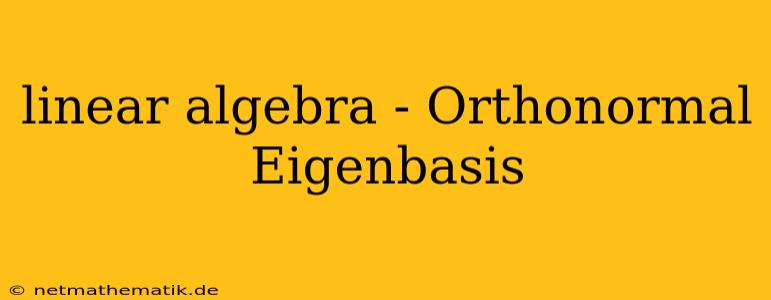Linear algebra is a fundamental branch of mathematics that deals with vectors, matrices, and linear transformations. One of the most important concepts in linear algebra is the eigenvalue problem. This problem seeks to find special vectors, known as eigenvectors, that remain unchanged in direction when a linear transformation is applied. The corresponding scalars are called eigenvalues, which scale the eigenvectors. In certain cases, it is possible to find a basis of eigenvectors for the vector space. This basis is called an orthonormal eigenbasis, which has profound implications in various fields such as physics, engineering, and computer science.
The Eigenvalue Problem
The eigenvalue problem arises when considering the effect of a linear transformation on a vector. Let $A$ be a square matrix representing a linear transformation and $\mathbf{x}$ be a non-zero vector. We seek vectors $\mathbf{x}$ that satisfy the following equation:
$A \mathbf{x} = \lambda \mathbf{x}$
where $\lambda$ is a scalar. This equation states that when the linear transformation represented by matrix $A$ is applied to the vector $\mathbf{x}$, the result is simply a scaled version of the original vector $\mathbf{x}$. The scalar $\lambda$ is known as the eigenvalue corresponding to the eigenvector $\mathbf{x}$.
Finding Eigenvalues and Eigenvectors
To find the eigenvalues and eigenvectors, we can rewrite the eigenvalue equation as:
$(A - \lambda I) \mathbf{x} = \mathbf{0}$
where $I$ is the identity matrix. This equation represents a homogeneous system of linear equations. A non-trivial solution (i.e., $\mathbf{x} \neq \mathbf{0}$) exists only if the determinant of the coefficient matrix $(A - \lambda I)$ is zero:
$\text{det}(A - \lambda I) = 0$
This equation is called the characteristic equation of matrix $A$. Solving the characteristic equation yields the eigenvalues $\lambda$. Once the eigenvalues are known, we can substitute each eigenvalue back into the equation $(A - \lambda I) \mathbf{x} = \mathbf{0}$ and solve for the corresponding eigenvector $\mathbf{x}$.
Orthonormal Eigenbasis
An orthonormal eigenbasis is a special type of basis for a vector space that consists entirely of eigenvectors of a linear transformation. Additionally, these eigenvectors are orthonormal, meaning they are orthogonal (perpendicular) to each other and have a unit norm (length of 1).
Properties of an Orthonormal Eigenbasis
- Orthogonality: Eigenvectors corresponding to distinct eigenvalues are always orthogonal. This property arises from the fact that the eigenvectors span different subspaces that are invariant under the linear transformation.
- Normalization: The eigenvectors can be normalized by dividing each vector by its norm, ensuring they have unit length.
- Completeness: If a matrix $A$ has $n$ linearly independent eigenvectors, these eigenvectors form a basis for the $n$-dimensional vector space. This means that any vector in the space can be expressed as a linear combination of these eigenvectors.
Importance of an Orthonormal Eigenbasis
The existence of an orthonormal eigenbasis provides significant advantages in analyzing and understanding linear transformations.
- Diagonalization: A matrix $A$ with an orthonormal eigenbasis can be diagonalized, meaning it can be transformed into a diagonal matrix $D$ using an orthogonal matrix $Q$. The diagonal elements of $D$ are the eigenvalues of $A$. Diagonalization simplifies many matrix operations, such as matrix multiplication and raising a matrix to a power.
- Simplified Analysis: The orthonormal eigenbasis allows us to decompose a vector space into subspaces that are invariant under the linear transformation. This decomposition provides a simpler representation of the transformation and facilitates the analysis of its properties.
- Applications in Physics and Engineering: Orthonormal eigenbases are widely used in various fields, including physics, engineering, and computer science. For instance, in quantum mechanics, the eigenvectors of a Hamiltonian operator represent the possible energy states of a system.
Finding an Orthonormal Eigenbasis
Not all matrices have a complete set of linearly independent eigenvectors. However, symmetric matrices, which are equal to their transpose, always have an orthonormal eigenbasis.
Gram-Schmidt Orthogonalization
If a matrix does not have an orthonormal eigenbasis, we can use the Gram-Schmidt orthogonalization process to construct an orthonormal basis from a set of linearly independent vectors. This process involves orthogonalizing a set of vectors by subtracting their projections onto the previously orthogonalized vectors.
Conclusion
The orthonormal eigenbasis is a powerful concept in linear algebra that simplifies the analysis of linear transformations and provides a basis for understanding their properties. Its applications are wide-ranging, extending to various fields where linear transformations are essential, including physics, engineering, and computer science. Understanding the importance and methods of finding an orthonormal eigenbasis is crucial for effective problem-solving in these domains.
